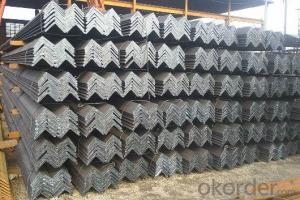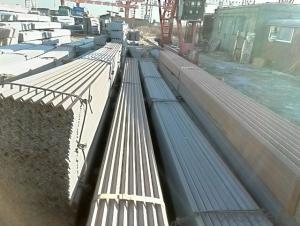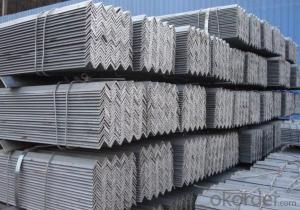Hot Rolled Angle Steel Bars with Highest Quality
- Loading Port:
- Tianjin
- Payment Terms:
- TT OR LC
- Min Order Qty:
- 25 m.t
- Supply Capability:
- 10000 m.t/month
OKorder Service Pledge
OKorder Financial Service
You Might Also Like
OKorder is offering Hot Rolled Equal Angles at great prices with worldwide shipping. Our supplier is a world-class manufacturer of steel, with our products utilized the world over. OKorder annually supplies products to European, North American and Asian markets. We provide quotations within 24 hours of receiving an inquiry and guarantee competitive prices.
Product Applications:
Hot Rolled Equal Angles are ideal for structural applications and are widely used in the construction of buildings and bridges, and the manufacturing, petrochemical, and transportation industries.
Product Advantages:
OKorder's Hot Rolled Equal Angles are durable, strong, and resist corrosion.
Main Product Features:
· Premium quality
· Prompt delivery & seaworthy packing (30 days after receiving deposit)
· Corrosion resistance
· Can be recycled and reused
· Mill test certification
· Professional Service
· Competitive pricing
Product Specifications:
Manufacture: Hot rolled
Grade: Q195 – 235
Certificates: ISO, SGS, BV, CIQ
Length: 6m – 12m, as per customer request
Packaging: Export packing, nude packing, bundled
Sizes: 25mm-250mm | ||
a*t | ||
25*2.5-4.0 | 70*6.0-9.0 | 130*9.0-15 |
30*2.5-6.6 | 75*6.0-9.0 | 140*10-14 |
36*3.0-5.0 | 80*5.0-10 | 150*10-20 |
38*2.3-6.0 | 90*7.0-10 | 160*10-16 |
40*3.0-5.0 | 100*6.0-12 | 175*12-15 |
45*4.0-6.0 | 110*8.0-10 | 180*12-18 |
50*4.0-6.0 | 120*6.0-15 | 200*14-25 |
60*4.0-8.0 | 125*8.0-14 | 250*25 |
FAQ:
Q1: Why buy Materials & Equipment from OKorder.com?
A1: All products offered byOKorder.com are carefully selected from China's most reliable manufacturing enterprises. Through its ISO certifications, OKorder.com adheres to the highest standards and a commitment to supply chain safety and customer satisfaction.
Q2: Can fit in the containers of 20fts the steel beams of 6M?
A2: No problem, we can put them into the containers in sideling form.
Q3: Can stainless steel rust?
A3: Stainless does not "rust" as you think of regular steel rusting with a red oxide on the surface that flakes off. If you see red rust it is probably due to some iron particles that have contaminated the surface of the stainless steel and it is these iron particles that are rusting. Look at the source of the rusting and see if you can remove it from the surface.
Images:


- Q: How do you prevent steel angles from corroding in saltwater environments?
- In order to prevent corrosion of steel angles in saltwater environments, there are several measures that can be taken: 1. Galvanization is a highly effective method for corrosion prevention. This involves applying a protective layer of zinc to the steel angles, which acts as a sacrificial anode and prevents direct contact with saltwater. The zinc coating corrodes instead of the steel, ensuring its longevity. 2. Barrier coatings, such as epoxy, polyurethane, or other corrosion-resistant paints, can be applied to provide an additional layer of protection against saltwater. These coatings act as a physical barrier, shielding the steel from the corrosive effects of saltwater. 3. Cathodic protection is another effective technique for preventing corrosion in saltwater environments. This involves connecting the steel angles to a sacrificial anode made of a more active metal, like aluminum or magnesium. The sacrificial anode corrodes instead of the steel, offering protection to the steel angles. 4. Regular maintenance is crucial to prevent corrosion in saltwater environments. This includes regularly inspecting and cleaning off any salt deposits or contaminants that may have accumulated. Any damaged or missing protective coatings should be repaired. Additionally, routine checks should be conducted to ensure the effectiveness of galvanization or cathodic protection systems. 5. Material selection plays a significant role in enhancing the resistance of steel angles to saltwater corrosion. Choosing corrosion-resistant alloys or stainless steel, such as grade 316 or duplex stainless steels, can greatly enhance their durability in saltwater environments. By implementing these preventive measures, the steel angles can be protected from the corrosive effects of saltwater, ensuring their long-lasting durability even in challenging marine conditions.
- Q: How do steel angles contribute to sustainable transportation infrastructure?
- Steel angles contribute to sustainable transportation infrastructure in several ways. Firstly, steel angles are a key component in the construction of bridges and highways. Their strength and durability make them ideal for supporting heavy loads and withstanding the harsh conditions that transportation infrastructure is exposed to. This means that structures built with steel angles have a longer lifespan, reducing the need for frequent repairs or replacements. This not only saves money but also reduces the environmental impact associated with the production and disposal of construction materials. Additionally, using steel angles in the construction of transportation infrastructure allows for more efficient designs. The versatility of steel angles enables engineers to create innovative and lightweight structures that require less material overall. This results in reduced energy consumption during the construction process and decreased emissions during transportation and installation. Furthermore, steel angles are recyclable. At the end of their lifespan, they can be easily recycled and used to manufacture new steel products. This reduces the demand for raw materials and minimizes waste sent to landfills. The recycling process also requires less energy and emits fewer greenhouse gases compared to the production of new steel, making it an environmentally friendly choice. Moreover, steel angles can contribute to sustainable transportation infrastructure by facilitating the integration of sustainable technologies. For example, they can be used to support solar panels or wind turbines, enabling the generation of clean energy to power transportation systems. By incorporating renewable energy sources into infrastructure projects, the reliance on fossil fuels can be reduced, leading to a decrease in greenhouse gas emissions and a more sustainable transportation system. In conclusion, steel angles play a crucial role in sustainable transportation infrastructure. Their strength, durability, recyclability, and ability to support sustainable technologies make them an environmentally friendly choice. By using steel angles in the construction of bridges, highways, and other transportation structures, we can create a more sustainable and resilient transportation system that reduces the environmental impact and promotes a greener future.
- Q: What are the different surface finishes for steel angles?
- Some of the different surface finishes for steel angles include mill finish, hot-dip galvanized, powder coated, and painted finishes.
- Q: What are the different connection methods for steel angles?
- There are several different connection methods for steel angles, depending on the specific application and structural requirements. Some common connection methods include: 1. Welding: Welding is one of the most common methods used to connect steel angles. It involves melting the adjacent surfaces of the angles and fusing them together using a welding electrode. This method provides high strength and rigidity but requires skilled labor and specialized equipment. 2. Bolting: Bolting is another widely used method for connecting steel angles. It involves fastening the angles together using bolts and nuts. Bolting offers the advantage of being easily adjustable and removable, making it suitable for situations where disassembly may be required. 3. Riveting: Riveting is a traditional method of connecting steel angles. It involves inserting a metal rivet through holes in the angles and then deforming the end to secure it in place. Riveting provides a strong and permanent connection but can be time-consuming and labor-intensive. 4. Adhesive bonding: Adhesive bonding is a modern method of connecting steel angles. It involves applying a high-strength adhesive to the contact surfaces of the angles and then joining them together. This method offers the advantage of being lightweight, flexible, and resistant to corrosion. 5. Mechanical fasteners: There are various mechanical fasteners available for connecting steel angles, such as self-tapping screws, self-drilling screws, and blind rivets. These fasteners provide a quick and easy way to connect angles without the need for additional tools or equipment. It is important to consider factors such as load requirements, structural stability, corrosion resistance, and ease of installation when selecting the appropriate connection method for steel angles.
- Q: What are the different types of steel angles used in automotive manufacturing?
- There are several types of steel angles used in automotive manufacturing, including equal angles, unequal angles, and L-shaped angles. These angles are commonly used in various structural components of vehicles, such as chassis frames, suspension systems, and body reinforcements.
- Q: How are steel angles protected against chemical exposure?
- Steel angles can be protected against chemical exposure through various methods. One common method is the application of protective coatings. These coatings, such as epoxy or polyurethane coatings, act as a barrier between the steel angle and the chemicals it may come into contact with. The coatings are designed to be resistant to chemical attack and prevent corrosion or degradation of the steel. Another method of protecting steel angles against chemical exposure is by using stainless steel. Stainless steel contains a high level of chromium, which forms a protective oxide layer on the surface of the steel. This oxide layer acts as a barrier against chemical attack, preventing corrosion and degradation of the steel angle. In addition to coatings and stainless steel, steel angles can also be protected by using acid-resistant materials. These materials are specifically designed to resist the corrosive effects of chemicals and can be used to line tanks or containers that store or transport chemicals. By using acid-resistant materials, the steel angle is shielded from direct contact with the chemicals, reducing the risk of corrosion or damage. Regular maintenance and inspection are also crucial for protecting steel angles against chemical exposure. Inspecting the angles for any signs of damage or corrosion allows for early detection and intervention. Any damaged protective coatings can be repaired or replaced to ensure the continued protection of the steel angle. Overall, steel angles can be protected against chemical exposure through the application of protective coatings, the use of stainless steel, the use of acid-resistant materials, and regular maintenance and inspection. These measures help to prevent corrosion, degradation, and damage to the steel angle, ensuring its longevity and performance in chemical environments.
- Q: How are steel angles used in construction?
- Steel angles have a wide range of applications in construction. They serve as important elements for providing structural support and reinforcement in buildings and other structures. Their primary function is to establish strong and stable connections between various components, including beams, columns, and trusses. The framework of a structure is typically formed using steel angles, which offer stability and strength. They can be utilized to create corners, support beams, and brace walls. Moreover, steel angles are commonly employed in the construction of lintels. These horizontal supports are placed above doors and windows to evenly distribute the weight of the structure and prevent any sagging. Apart from their structural purposes, steel angles can also contribute to the aesthetic appeal of a building. They can be used to create decorative edging or trim, enhancing the visual attractiveness of the structure. Additionally, steel angles can be employed in the construction of staircases, handrails, and other architectural features. In summary, steel angles are indispensable and versatile components in the field of construction. They fulfill crucial roles by providing structural support, reinforcement, and aesthetic elements. As a result, they ensure the durability, stability, and visual appeal of buildings and other structures.
- Q: Can steel angles be used for support brackets?
- Yes, steel angles can be used for support brackets. Steel angles are commonly used in construction and engineering applications due to their strength and versatility. They have a triangular shape with equal sides and can be easily fastened to walls, beams, or other structures to provide support. Steel angles are frequently used as support brackets for shelving, countertops, and other heavy items. They are capable of bearing significant loads and provide stability and durability to the supported structure.
- Q: How do steel angles perform in corrosive gas or liquid environments?
- Steel angles are generally used in various structural applications due to their strength and versatility. However, their performance in corrosive gas or liquid environments can be affected by the specific grade of steel used and the concentration and nature of the corrosive substance. In the presence of corrosive gases or liquids, steel angles can experience corrosion, which can lead to a degradation of their structural integrity over time. The level of corrosion depends on factors such as the exposure time, temperature, humidity, and the corrosivity of the gas or liquid. To mitigate the effects of corrosion, steel angles used in corrosive environments can be coated with protective layers. Common protective coatings include galvanization, which involves applying a layer of zinc to the steel surface, or the use of epoxy or polyurethane coatings. These coatings act as a barrier, preventing direct contact between the corrosive substance and the steel, thereby slowing down the corrosion process. However, it is important to note that even with protective coatings, steel angles may still experience some level of corrosion over time. The extent of corrosion will depend on the quality and durability of the coating, as well as the maintenance and regular inspection of the steel angles. In extremely aggressive or highly concentrated corrosive environments, steel angles may not be the best choice. In such cases, alternative materials such as stainless steel or corrosion-resistant alloys may be more suitable options. In conclusion, while steel angles can be used in corrosive gas or liquid environments, their performance will be influenced by the specific conditions and the protective measures in place. Regular inspection, proper maintenance, and the use of appropriate coatings can help ensure the longevity and performance of steel angles in corrosive environments.
- Q: What are the different types of steel angles used in signage structures?
- There are several types of steel angles commonly used in signage structures, including equal angles, unequal angles, and L-shaped angles. These angles provide structural support and stability to signage installations, ensuring durability and longevity.
Send your message to us
Hot Rolled Angle Steel Bars with Highest Quality
- Loading Port:
- Tianjin
- Payment Terms:
- TT OR LC
- Min Order Qty:
- 25 m.t
- Supply Capability:
- 10000 m.t/month
OKorder Service Pledge
OKorder Financial Service
Similar products
Hot products
Hot Searches
Related keywords



























